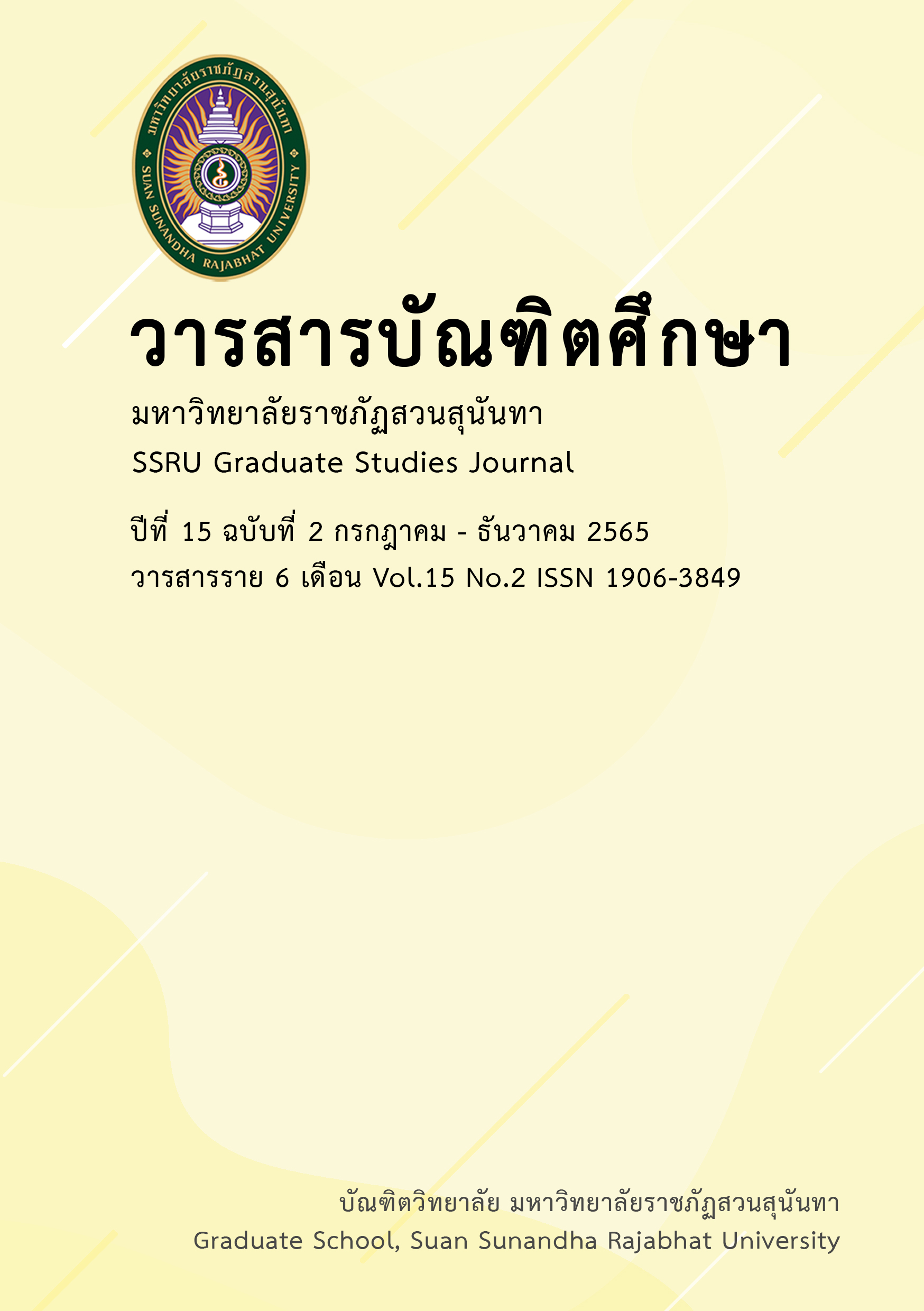The Influences of Demographic Characteristics and Job Satisfaction on the Organizational Commitment of Employees in a Commercial Bank in Bangkok and Its Metropolitan Areas
Main Article Content
Abstract
The objective of this research were to study the influences of demographic characteristics and work satisfaction on organizational commitment in a commercial bank in Bangkok and its metropolitan areas. The sample consisted of 300 operation-level staff of the commercial bank. They were selected via convenient sapling technique. Data were collected with the use of a questionnaire and analyzed with descriptive statistics including percentage, mean and standard deviation. Moreover, t-test was used in the comparison of two groups of samples and F- test or (One-way ANOVA) was employed in the case of three group comparison. Multiple regression analysis was employed. The research results indicated that most respondents were female, aged between 31 and 50 years, single, obtained bachelor’s degree, had work experiences of 10 years or more, had the position of assistant managers and earned more than 35,000 baht. Additionally, different demographic factors including gender and marital status were found to have no significant influence on the organizational commitment with the organization. However, other demographic factors including age, education level, work experience, job position and income had not influence on this factor. In terms of job satisfaction, the aspects of benefits, welfare, supervisors and colleagues were found to have an influence on the organizational commitment with a statistical significance level of 0.05 whereas job characteristics had no influence.
Article Details
References
จรรยา ห่วงเทศ. (2558). ปัจจัยที่มีความสัมพันธ์กับความผูกพันต่อองค์การของพนักงานธนาคารกรุงศรีอยุธยา จำกัด (มหาชน) ภาค 208. (ปริญญามหาบัณฑิต). กรุงเทพฯ: มหาวิทยาลัยศิลปากร.
จักรกฤษณ์ สำราญใจ. (2544). การกำหนดขนาดของกลุ่มตัวอย่างเพื่อการวิจัย. กรุงเทพฯ: ซีดอ็ดยูเคชั่น.
ธนาคารไทยพาณิชย์. (2563). รายงานประจำปี 2563. สืบค้นเมื่อ ธันวาคม 15, 2563, จาก https://www.scb.co.th/content/dam/scb/investor-relations/documents/financial-information/th/2563/annual-report/2020annualreport-th.pdf?form=2.
พิชิต เทพวรรณ์. (2554). การจัดการทรัพยากรมนุษย์เชิงกลยุทธ์. กรุงเทพฯ: ซีเอ็ดยูเคชั่น.
พูนสิทธ์ ว่องธวัชชัย. (2562). แนวโน้มธุรกิจธนาคารในปี 2562: ถนนทุกสายมุ่งสู่ดิจิทัล. สืบค้นเมื่อ มีนาคม 30, 2564, จาก https://www.bangkokbiznews.com/blog/detail/6446607.
ลลิตา จันทร์งาม. (2559). ปัจจัยที่ส่งผลต่อความผูกพันต่อองค์การของพนักงาน ธนาคารออมสิน สำนักงานใหญ่กลุ่มลูกค้าบุคคล. (ปริญญามหาบัณฑิต). กรุงเทพฯ: มหาวิทยาลัยธรรมศาสตร์.
วรรณิภา นิลวรรณ. (2554). ความผูกพันต่อองค์การของข้าราชการครูและบุคลากรทางการศึกษาในวิทยาลัยอาชีวศึกษาสุราษฎร์ธานี จังหวัดสุราษฎร์ธานี. (ปริญญามหาบัณฑิต). ปทุมธานี: มหาวิทยาลัยเทคโนโลยีราชมงคลธัญบุรี.
โศรตี โชคคุณะวัฒนา. (2559). คุณภาพชีวิตในการทำงานที่มีผลต่อความผูกพันต่อองค์กร ของพนักงานธนาคารกรุงไทย สำนักงานใหญ่. (ปริญญามหาบัณฑิต). กรุงเทพฯ: มหาวิทยาลัยศรีนครินทรวิโรฒ.
สกาว สำราญคง. (2547). การพัฒนาแบบวัดความผูกพันของพนักงาน กรณีศึกษาบริษัทในกลุ่มสมบูรณ์. (ปริญญามหาบัณฑิต). กรุงเทพฯ: สถาบันบัณฑิตพัฒนบริหารศาสตร์.
สิริอร วิชชาวุธ. (2554). จิตวิทยาการเรียนรู้. กรุงเทพฯ: สำนักพิมพ์มหาวิทยาลัยธรรมศาสตร์.
อรอุสา เกสรสังข์. (2550). ปัจจัยที่มีผลต่อความผูกพันองค์กรของพนักงานธนาคารไทยพาณิชย์สำนักงานใหญ่. (ปริญญามหาบัณฑิต). กรุงเทพฯ: มหาวิทยาลัเซนต์จอห์น.
Bashir, N., & Long, C. S. (2015). The relationship between training and organizational commitment among academicians in Malaysia. Journal of Management Development, 34(10), 1227-1245.
Buchanan, B. (1974). Building organizational commitment: The socialization of managers in work organizations. Administrative Science Quarterly, 19, 533-546. doi:10.2307/2391809.
Emmema, A. A., Ajjan, N., & Karthikeyan, C. (2012). Factors influencing employee engagement in an entertainment industry. International o Research in Commerce & Management, 3(8), 35-42.
Herzberg, F. (1959). The motivation. New York: John Wiley & Sons.
Hewitt Associates. (2003). Identify factors driving employee engagement. (Online). Retrieved October 14, 2008, from http://www.hewittassociates.com/Intl/NA/en US/Our Services/Service Tool.aspx?.
Judge, T. A., Thoresen, C. J., Bono, J. E., & Patton, G. K. (2001). The job satisfaction-job performance relationship: A qualitative and quantitative review. Psychological Bulletin, 127(3), 376-407.
Marwan, Al-Zoubi. (2012). The shape of the relationship between salary & job satisfaction: A field study. Far East journal of Psychology and Business, 7(3), 1-12.
Maslow, A. H. (1970). Motivation and personality (2nd ed.). New York: Harper and Row.
Mowday, R. T. (1999). Reflections on the study and relevance of organizational commitment. Human Resource Management Review, 8(4), 387-401
Porter, L. W., Steers, R. M., Mowday, R. T., & Boulian, P. V. (1974). Organizational commitment, job satisfaction, and turnover among psychiatric technicians. Journal of Applied Psychology, 59, 603-609.
Yamane, Taro. (1970). Statistical an introductory analysis (2nd ed.). Ed Tokyo: John Weather Thill.


